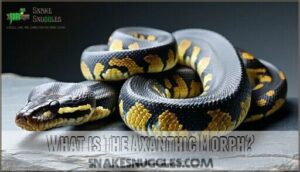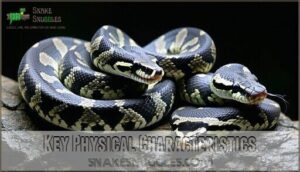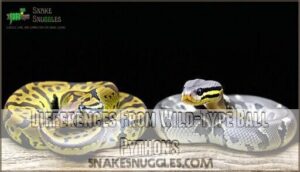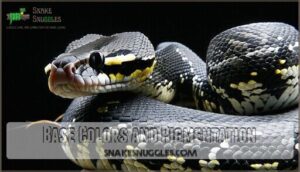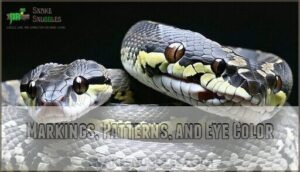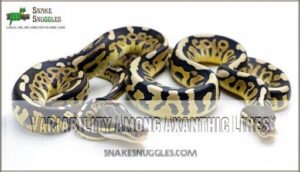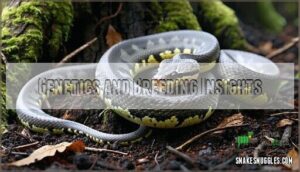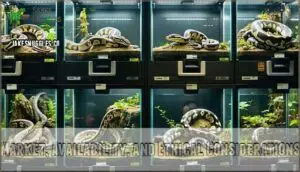This site is supported by our readers. We may earn a commission, at no cost to you, if you purchase through links.
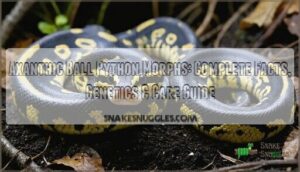
But here’s where axanthics get really interesting—they’re breeding powerhouses that unlock incredible combinations with other morphs.
VPI’s bloodline leads the pack as the most reliable source, but breeders now work with several proven lines.
Here’s the breeding reality: you need two parents carrying the axanthic gene to get visual offspring. It’s basic recessive genetics at work.
These striking black-and-white snakes grow just as large as regular ball pythons—hitting that 4-6 foot mark—but sell for significantly more thanks to their photographic appearance and serious breeding value.
Table Of Contents
- Key Takeaways
- Axanthic Ball Python Morph Facts
- Appearance and Coloration Details
- Genetics and Breeding Insights
- Care, Behavior, and Husbandry
- Market, Availability, and Ethical Considerations
- Frequently Asked Questions (FAQs)
- What are the characteristics of the Axanthic ball python?
- What do Axanthic ball pythons eat?
- What is the most sought after ball python morphs?
- What is the prettiest ball python morph?
- What are the rarest axanthic ball python morphs?
- Are axanthic ball pythons more prone to health issues?
- Can axanthic ball pythons be bred with other morphs?
- Can axanthic ball pythons see colors normally?
- Do axanthic morphs have shorter lifespans?
- Are axanthic ball pythons more aggressive?
- Conclusion
Key Takeaways
- Axanthic ball pythons completely lack yellow and red pigments, creating stunning black, white, and gray patterns that look like living photographs – this recessive genetic trait transforms normal ball python colors into striking monochromatic displays.
- The VPI line from 1997 remains the most established bloodline, though multiple incompatible genetic lines exist (TSK, Jolliff, MJ) – breeding different lines together produces normal-looking offspring, not axanthic ones.
- Simple recessive genetics means both parents must carry the axanthic gene for visual offspring – only 25% of babies from two carriers will show the axanthic trait, making genetic testing crucial for breeding programs.
- These morphs are genetic goldmines for creating designer combinations – pairing axanthic with other traits like pastel or enchi produces valuable designer morphs that can command $700-$1,500+ compared to basic axanthics at $125.
Axanthic Ball Python Morph Facts
Axanthic ball pythons are a striking morph that completely lacks yellow pigment, creating a stunning monochromatic appearance in shades of black, white, gray, and brown.
VPI developed this recessive trait back in 1997, and it’s been a hit with snake lovers ever since.
The gene strips away all that typical yellow coloring and leaves you with this clean, high-contrast look that really pops.
What is The Axanthic Morph?
Imagine a ball python that looks like it stepped straight out of a black-and-white photograph—that’s the striking beauty of an axanthic morph. This snake color mutation removes all yellow pigment from the snake’s skin. The genetic basis is a recessive trait that creates a stunning visual impact through pigment absence.
Axanthic ball pythons look like living black-and-white photographs, completely lacking yellow pigment through a recessive genetic mutation
Here’s what makes axanthic ball pythons special:
- Complete yellow removal – No yellow coloration anywhere on the body
- Monochromatic appearance – Only blacks, grays, whites, and browns remain
- Recessive inheritance – Both parents must carry the gene for expression
Key Physical Characteristics
The first thing you’ll notice about an axanthic ball python is what’s missing—that warm yellow glow that makes regular ball pythons look like they’re basking in sunlight. Instead, you get monochrome coloration that’s all grays, blacks, and whites.
The axanthic morph creates pattern reduction too, making their markings less defined. They’re the same size as wild-types though—still reaching 4-6 feet with that classic triangular head shape.
History and Development of The Morph
Ball python enthusiasts’ fascination with unusual color patterns led to early imports of wild-caught axanthic specimens from West Africa in the late 1980s. The VPI Lineage emerged when Vida Preciosa International acquired their foundation female in 1990. Recessive genetics became clear in 1997 when VPI successfully bred the first captive axanthic offspring, proving this snake color mutation followed simple inheritance patterns. The mutation results in snakes that lack red pigment.
Key milestones in Axanthic Morph Development include:
- 1990-1997: Wild imports and initial breeding attempts with adult females
- 1997: First proven recessive breeding success establishing Axanthic Ball Python Genetics
- 2000s onwards: Multiple independent lines (TSK, Joliff, MJ) and growing Morph Popularity
These days, genetic testing lets breeders confirm which line they’re working with, and online markets have made it easier to track bloodlines.
Meanwhile, breeders keep pushing boundaries—selectively breeding for even better color retention and cleaner pigment expression.
Differences From Wild-Type Ball Pythons
When you place an axanthic ball python next to a wild-type, it’s like looking at a black-and-white photograph beside a full-color image. The axanthic’s color palette lacks all yellow pigmentation, creating dramatic pattern reduction.
But wild pythons flash those rich browns and golds for a reason—axanthic genetics wipe out every trace of yellow pigment.
Without those warm tones, you get these incredible grayscale versions of familiar morphs that really pop against their colorful cousins.
Appearance and Coloration Details
Axanthic ball pythons showcase a striking monochromatic appearance that sets them apart from their wild cousins. Without yellow pigment, these snakes display beautiful combinations of silver, gray, white, black, and brown that create stunning visual contrast.
Base Colors and Pigmentation
Strip away the yellows and golds, and you’re left with nature’s grayscale masterpiece. Your Axanthic Ball Python showcases pure melanin without yellow interference.
Melanophores produce rich blacks and deep grays. Temperature effects can shift color intensity slightly.
The pigment cell types create striking silver-white contrast against darker melanin patches.
Markings, Patterns, and Eye Color
Beyond the striking absence of yellow, axanthic ball pythons showcase intricate patterns that stand out like silver engravings against a charcoal canvas.
Their markings reveal unique characteristics:
- Pattern Reduction: Clean, bold alien heads and saddles without busy detail
- Scale Iridescence: Subtle metallic sheen catches light beautifully
- Eye Variations: Dark brown to black eyes complement their monochrome palette
These Ball Python morph features create stunning visual contrast in axanthic ball python morphs.
Variability Among Axanthic Lines
You’ll find major differences between axanthic lines that go way beyond simple color fading. VPI Axanthic ball pythons show distinct genetic mutation origins compared to TSK, Jolliff, and MJ lines.
Here’s the thing about crossing different axanthic lines – you won’t get axanthic babies. Since VPI, TSK, Jolliff, and MJ axanthics come from separate genetic mutations, breeding them together just gives you normal-looking offspring.
Pattern contrast differences vary greatly – some VPI axanthics keep sharp silver markings while others brown out completely by age three. The MJ Axanthic line was developed in 2008.
Genetics and Breeding Insights
Getting axanthic genetics right makes all the difference in your breeding program.
The axanthic trait works as a simple recessive gene, which means you need two copies for the snake to show the lack of yellow pigment.
Recessive Genetic Mutation Explained
Think of genetics like a recipe card passed down through generations—the axanthic mutation is what happens when one key ingredient gets permanently crossed out. In this case, the gene responsible for yellow pigment production gets switched off.
This recessive genetic mutation means both parents must carry the axanthic gene for their offspring to show the trait. That’s why breeding outcomes depend entirely on genetic inheritance patterns and proper trait visualization.
Heterozygous Vs Homozygous Axanthics
When you breed two axanthic carriers together, you’re basically rolling genetic dice. Only about 25% of the babies will actually show that stunning gray-scale look you’re after.
The rest are either normal-looking carriers (heterozygous) or completely wild-type. Visual hets don’t exist with axanthic ball python genetics, so genetic testing becomes your best friend for het identification and planning future breeding outcomes.
Breeding Combinations and Designer Morphs
Mixing axanthic genes with other ball python morphs opens up a whole world of stunning designer combinations that’ll make your breeding projects shine. Here’s what you can create:
- Axanthic Pastel – reduces pattern intensity while maintaining clean lines
- Enchi Pastel Clown combos – create striking contrast patterns
- Pastel VPI Axanthic Shrapnel Pinstripe – complex gene interactions produce remarkable visual effects
Double Het combos let you work toward future breeding goals, while Visual Identification tips help track your new morph potential.
The VPI Line and Other Genetic Lines
Four major axanthic lines exist in ball pythons, each genetically incompatible with the others. The VPI lineage traces back to a single 1990 founder animal, making it the most common line available today. TSK, Jolliff, and MJ lines developed independently with different mutations.
When you cross different lines, offspring appear normal—not axanthic. Molecular testing can verify true VPI genetics through DNA analysis.
Care, Behavior, and Husbandry
Axanthic ball pythons need the same basic care as any other ball python. The key things are getting your enclosure dialed in, sticking to a regular feeding routine, and working with their naturally mellow personality.
Enclosure and Environmental Needs
Your axanthic ball python’s home needs to mirror the warm, humid forests of West Africa where their wild cousins thrive.
Create temperature gradients with a basking spot at 88-92°F and cool side at 78-80°F. Maintain humidity control between 55-60%. Choose substrate options like cypress mulch or paper towels.
Provide an enclosure size of at least 40 gallons for adults with enrichment ideas like hiding spots and climbing branches.
Diet, Feeding, and Hydration
Feeding your axanthic ball python isn’t rocket science, but getting it right makes all the difference between a thriving snake and one that struggles. Your Python regius needs prey that matches their body thickness—too big causes regurgitation, too small leaves them hungry.
Key feeding basics for ball python care:
- Prey size: Choose rodents as wide as your snake’s thickest section
- Feeding frequency: Adults eat every 2-3 weeks, juveniles weekly
- Water quality: Provide fresh, dechlorinated water in a heavy bowl
Ball python diet refusal reasons include stress, shedding, or breeding season. Skip supplementation—whole prey provides complete nutrition naturally.
Temperament and Handling
Ball pythons earned their nickname "pet rocks with scales" for good reason – these snakes are naturally calm, docile creatures that rarely show aggression toward humans. Your axanthic ball python will likely tolerate handling well with minimal bite risk.
Start with short sessions to build trust. These nonvenomous snakes make excellent pets for responsible children when supervised.
Ball python behavior remains consistent across morphs – gentle handling frequency helps maintain their docile ball python characteristics.
Lifespan and General Health
When you’re investing in an axanthic ball python, you’re looking at a long-term commitment that can span decades with proper care. These snakes usually live 20-30 years in captivity.
Ball python characteristics include hardy genetics with few genetic predispositions to disease. Common ailments like respiratory infections and mites are preventable through proper husbandry.
Longevity factors include consistent temperatures, clean environments, and regular veterinary needs checkups for preventative care.
Market, Availability, and Ethical Considerations
Getting an axanthic ball python means knowing where to shop and what you’ll pay. Responsible breeding and ethical ownership protect both the animals and the hobby for future generations.
Where to Buy Axanthic Ball Pythons
Finding quality axanthic ball pythons isn’t like shopping for groceries—you can’t just walk into any pet store and expect to find these stunning morphs on the shelf. You’ll need to connect with specialized reptile breeders who focus on ball python morphs.
Here’s where to start your search:
- Established reptile breeders with proven breeder reputation
- Reptile expos and shows for hands-on morph variety selection
- Online reptile sales platforms offering shipping considerations
- Local herpetological societies providing trusted referrals
Look for sellers offering health guarantees and transparent pricing factors before committing to any axanthic ball python purchase.
Price Factors and Rarity
Across today’s Morph Market Trends, your axanthic ball python’s value depends on multiple factors. Basic axanthic ball python morphs start around $125 for hatchlings, while genetic combo values skyrocket—designer morphs like Axanthic Firefly reach $700-$1,500.
Adult breeding pair investment varies greatly by sex and quality. Seasonal price swings affect timing, with spring premiums hitting 15-30%.
The rarity tiering system places standard axanthics as common, but snake morphs combining recessive mutation traits become ultra-rare, commanding thousands in reptile sales.
Captive Breeding Programs
Successful breeding programs have transformed axanthic ball pythons from a rare genetic anomaly into one of the most popular morphs in the reptile world. These captive breeding initiatives focus on genetic diversity while creating stunning new combinations:
- Morph creation through careful genetic pairing
- Snake genetics research advancing our understanding
- Breeding challenges overcome through selective programs
- Conservation impact reducing wild collection pressure
Professional reptile breeding operations now maintain detailed genetic records, guaranteeing healthy bloodlines for future Ball Python Morphs development.
Responsible Ownership and Conservation
Getting axanthics means stepping up as a responsible owner. You want captive-bred snakes from reputable breeders—not wild-caught animals that fuel illegal trade.
Snake genetics research shows welfare risks with intensive breeding, so choose experienced breeders carefully.
Your purchase affects conservation efforts—wild populations face serious pressure from collection. Community action through responsible ownership helps protect these wonderful snakes.
Frequently Asked Questions (FAQs)
What are the characteristics of the Axanthic ball python?
The axanthic morph creates stunning monochromatic colors by removing yellow pigment entirely. You’ll notice pattern reduction compared to wild-type ball pythons, plus identical size variation and head shape.
Their temperament traits remain gentle and docile like standard morphs.
What do Axanthic ball pythons eat?
Unlike their flashy cousins who demand gourmet meals, Axanthic Ball Pythons eat the same prey as any Python regius.
Your ball python morph needs:
- Prey Size: Rodents matching your snake’s thickest body section
- Feeding Frequency: Juveniles weekly, adults every 2-3 weeks
- Frozen-Thawed: Safer than live feeding for ball python morphs
Supplementation isn’t needed with whole prey.
What is the most sought after ball python morphs?
Popular ball python morphs command top prices in the collectors market. Morphs like Blue-Eyed Leucistic, Sunset, and Piebald show strong investment potential due to their unique traits and visual appeal.
What is the prettiest ball python morph?
Beauty varies by personal experience and pattern preference. Some breeders favor Mojave ghosts for their "lovely combination of fascinating adult pattern and texture."
Color combinations, rarity appeal, and subjective beauty make ball python morph preferences highly individual among snake morph enthusiasts.
What are the rarest axanthic ball python morphs?
Think of looking for diamonds in your backyard—you’ll likely find quartz instead. Several ultra-rare axanthic combinations command outrageous prices due to limited availability and new discoveries.
The rarest Expensive Axanthics include:
- Super Fire VPI Axanthic – Genetic combinations create stunning contrast patterns
- Axanthic Coral Glow – High-demand morph with limited breeding success
- VPI Axanthic Sunset – Recently discovered with unique orange undertones
- Axanthic Stranger – Experimental morph with unpredictable genetics
- Black Pastel Axanthic – Dark enhancement creates museum-quality specimens
These ball python morphs remain scarce because the axanthic morph requires careful breeding. The VPI Axanthic line forms the foundation, but combining it with other rare genes creates these coveted designer morphs that serious collectors chase.
Are axanthic ball pythons more prone to health issues?
Here’s the reassuring truth: axanthic ball pythons are just as healthy as regular ball pythons.
The genetic change only affects their coloring—it doesn’t mess with their immune system or any vital functions.
| Health Factor | Axanthic Ball Python | Wild-Type Ball Python |
|---|---|---|
| Genetic Predispositions | No increased risk | Standard risk levels |
| Scaled Anomalies | Same occurrence rate | Same occurrence rate |
| Immune Deficiency | No deficiency noted | No deficiency noted |
| Breeding Complications | Normal fertility rates | Normal fertility rates |
| Lifespan Impact | 20-30 years typical | 20-30 years typical |
The mutation that creates these striking color morphs targets reptile pigmentation genes specifically. Your axanthic ball python’s genetic traits won’t compromise their overall health or longevity.
Can axanthic ball pythons be bred with other morphs?
Mixing axanthic with other ball python morphs creates stunning designer morphs. The genetic compatibility allows breeders to combine axanthic’s grayscale beauty with genes like albino or piebald.
These combination outcomes produce visual variations that showcase remarkable breeding complexity while maintaining healthy genetic traits.
Can axanthic ball pythons see colors normally?
Your axanthic ball python sees colors just like any normal ball python. The missing yellow pigmentation in their skin doesn’t affect their eye structure or visual acuity.
They detect prey through normal light spectrum perception, since axanthic only impacts xanthophores in skin coloration, not vision.
Do axanthic morphs have shorter lifespans?
Lifespan studies show axanthic morphs live just as long as normal ball python morphs. These genetic traits don’t impact life expectancy.
With proper husbandry effects, your axanthic ball python will reach 20-30 years.
Are axanthic ball pythons more aggressive?
Does snake coloration affect temperament? No, axanthic ball python morphs show no aggression differences from wild-type snakes. The genetic mutation only impacts pigmentation, not behavior.
- Handling Differences: None – axanthic morphs handle identically to normal ball pythons
- Temperament Myths: Color genetics don’t influence personality or aggression levels
- Captivity Effects: All ball python morphs adapt equally well to handling
- Genetic Influence: The axanthic gene affects only yellow pigment production
- Individual Variation: Personality differs between snakes regardless of morph type
Your axanthic ball python’s temperament depends on individual personality, not coloration genetics.
Conclusion
Imagine this: most ball pythons sell for $50-200, but top axanthic specimens command $2,000+ because breeders know their genetic worth. These monochromatic beauties aren’t just stunning pets—they’re living blueprints for creating tomorrow’s designer morphs.
Understanding axanthic ball python morphs facts means grasping both their simple care needs and complex breeding potential. Whether you’re starting your first collection or expanding your breeding program, these black-and-white gems offer the perfect blend of visual impact and genetic versatility that keeps the hobby evolving.
- https://www.biorxiv.org/content/10.1101/2024.05.22.595308v3.full.pdf
- https://www.ralphdavisreptiles.com/collection/pythons/ball/axanthic_ball_python.asp
- https://www.reddit.com/r/ballpython/comments/icagfh/lightning_axanthic_pied_breeding/
- https://www.worldofballpythons.com/wizard/
- https://community.morphmarket.com/t/top-100-ball-python-genes-jan-2020/5442

